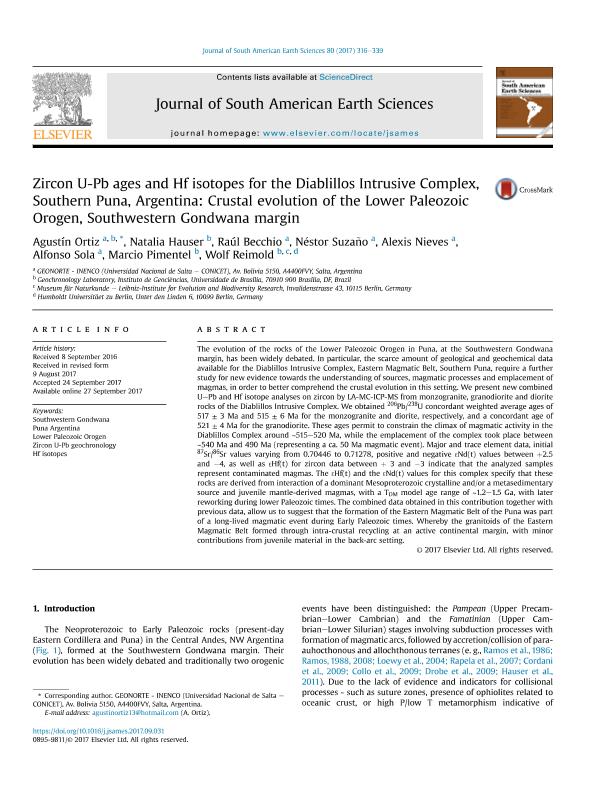Artículo
Zircon U-Pb ages and Hf isotopes for the Diablillos Intrusive Complex, Southern Puna, Argentina: Crustal evolution of the Lower Paleozoic Orogen, Southwestern Gondwana margin
Ortiz Yañez, Agustín ; Hauser, Natalia
; Hauser, Natalia ; Becchio, Raul Alberto
; Becchio, Raul Alberto ; Suzaño, Nestor Omar
; Suzaño, Nestor Omar ; Nieves, Alexis Iván Angel
; Nieves, Alexis Iván Angel ; Sola, Alfonso Manuel
; Sola, Alfonso Manuel ; Pimentel, Marcio; Reimold, Wolf
; Pimentel, Marcio; Reimold, Wolf
 ; Hauser, Natalia
; Hauser, Natalia ; Becchio, Raul Alberto
; Becchio, Raul Alberto ; Suzaño, Nestor Omar
; Suzaño, Nestor Omar ; Nieves, Alexis Iván Angel
; Nieves, Alexis Iván Angel ; Sola, Alfonso Manuel
; Sola, Alfonso Manuel ; Pimentel, Marcio; Reimold, Wolf
; Pimentel, Marcio; Reimold, Wolf
Fecha de publicación:
12/2017
Editorial:
Pergamon-Elsevier Science Ltd
Revista:
Journal of South American Earth Sciences
ISSN:
0895-9811
Idioma:
Inglés
Tipo de recurso:
Artículo publicado
Clasificación temática:
Resumen
The evolution of the rocks of the Lower Paleozoic Orogen in Puna, at the Southwestern Gondwana margin, has been widely debated. In particular, the scarce amount of geological and geochemical data available for the Diablillos Intrusive Complex, Eastern Magmatic Belt, Southern Puna, require a further study for new evidence towards the understanding of sources, magmatic processes and ofmagmas, in order to better comprehend the crustal evolution in this setting. We present new combined UePb and Hf isotope analyses on zircon by LA-MC-ICP-MS from monzogranite, granodiorite and diorite rocks of the Diablillos Intrusive Complex. We obtained 206Pb/238U concordant weighted average ages of 517 ± 3 Ma and 515 ± 6 Ma for the monzogranite and diorite, respectively, and a concordant age of 521 ± 4 Ma for the granodiorite. These ages permit to constrain the climax of magmatic activity in the Diablillos Complex around ~515e520 Ma, while the emplacement of the complex took place between ~540 Ma and 490 Ma (representing a ca. 50 Ma magmatic event). Major and trace element data, initial87Sr/86Sr values varying from 0.70446 to 0.71278, positive and negative 3Nd(t) values between þ2.5 and 4, as well as 3Hf(t) for zircon data between þ 3 and 3 indicate that the analyzed samples represent contaminated magmas. The 3Hf(t) and the 3Nd(t) values for this complex specify that these rocks are derived from interaction of a dominant Mesoproterozoic crystalline and/or a metasedimentarysource and juvenile mantle-derived magmas, with a TDM model age range of ~1.2e1.5 Ga, with later reworking during lower Paleozoic times. The combined data obtained in this contribution together with previous data, allow us to suggest that the formation of the Eastern Magmatic Belt of the Puna was partof a long-lived magmatic event during Early Paleozoic times. Whereby the granitoids of the Eastern Magmatic Belt formed through intra-crustal recycling at an active continental margin, with minor contributions from juvenile material in the back-arc setting.
Archivos asociados
Licencia
Identificadores
Colecciones
Articulos(INENCO)
Articulos de INST.DE INVEST.EN ENERGIA NO CONVENCIONAL
Articulos de INST.DE INVEST.EN ENERGIA NO CONVENCIONAL
Articulos(SEDE CENTRAL)
Articulos de SEDE CENTRAL
Articulos de SEDE CENTRAL
Citación
Ortiz Yañez, Agustín; Hauser, Natalia; Becchio, Raul Alberto; Suzaño, Nestor Omar; Nieves, Alexis Iván Angel; et al.; Zircon U-Pb ages and Hf isotopes for the Diablillos Intrusive Complex, Southern Puna, Argentina: Crustal evolution of the Lower Paleozoic Orogen, Southwestern Gondwana margin; Pergamon-Elsevier Science Ltd; Journal of South American Earth Sciences; 80; 12-2017; 316-339
Compartir
Altmétricas



